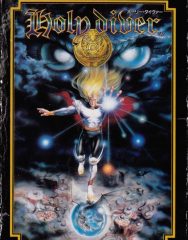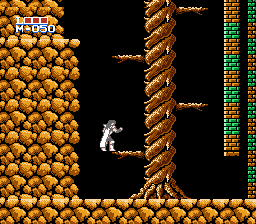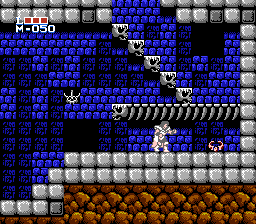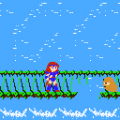Though not extraordinarily well known in North America, Irem released several quality games, most of which were designated for public arcades. Their primary claim to fame is the (in)famous R-Type series of sci-fi shoot-em-ups, famed for their power-ups systems and tight gameplay, freakish stage and enemy design, and their unrelenting brutality. Their 8-bit console output was generally distilled in terms of pain compared to their arcade presence, but they did at least slip by one cartridge of such inconceivable malice and wretched horror with a curious title inspired by American heavy metal: Holy Diver, a title most closely associated with seminal heavy metal album by the late, great rock god Ronnie James Dio.
Yes, the game is influenced by images evoked when you think of the power of ROCK and METAL and SATAN and everything that has to do with eighties hard music. It is difficult to write the game’s name off as a mere coincidence when you consider its storyline, an awesome intro that references Slayer and King Crimson in its first paragraph and pays bid to Ronnie (James Dio), Ozzy (Osbourne), Randy (Rhoads, famed guitarist with Ozzy before his death), and Zakk (Wylde, also famous for playing with Ozzy). Behold the power of rock in video game text form:
Resurrected-The Legend of the Holy Magic King’s Justice
It is the 666th year of the world of magic. The Black Slayer, Demon King of the Underground Dark Empire, has extended the world of darkness and weakened the power of King Crimson whose wisdom has guided the world of magic for generations.
The 16th Crimson Emperor Ronnie 4th entrusted his two infant sons, Randy and Zack, to his faithful servant Ozzy. The three escaped the forces from another dimension in the hope to bring light back into the world.
The next 17 years were difficult but Randy, Zack, and Ozzy devoted themselves to the cause of Holy Magic Justice. The Black Slayer had further extended his empire over the countryside and the interdimensional forces were even more powerful. Randy needed to find the Royal Coat Of Arms of the Crimson to battle the demons. He set out alone to carry out the will of his surrogate father Ozzy who had passed away. Thus begins the Legend Of The Holy Magic King’s Justice.
Perhaps the only other story that even comes close to the magnitude of sheer marvel is the intro to Zombie Nation / Abarenbou Tengu, but that’s neither here nor there. You control Randy on a quest to obliterate the Black Slayer and restore power to the lineage of King Crimson, though you wouldn’t know much of this just looking at the game. In fact, just looking at it is likely to bring Castlevania to mind. Holy Diver is a nigh-shameless ripoff of Castlevania in terms of visual design and gameplay, but this is not necessarily a fault. There is enough here to distinguish its identity from the Belmont saga starting with the lack of whips. Randy attacks with an infinite supply of fireballs by default, and though they are not too powerful and somewhat short-ranged (flying through only a fourth of the screen width), he can fire them quickly and can also shoot upward if need be. He can also turn from white to blue with a press of Select and shoot out twin fireballs which travel the whole screen. While doing more damage and safer to use, each twin fire shot takes up one mana point and it cannot be used recklessly.
The goal in Holy Diver is simple enough: Get to the end of each stage and slay the boss before you succumb to the waves of enemies and pitfalls that will aim to fail your quest. There are six stages in all, same as the first Castlevania, and doubling as a nod to the number of the beast. For better or worse, there’s a wide variety of enemies to deal with in each stage, with at least one new monster (but often several more) to be found in the next area. The basic red executioner foot soldiers and winged knights in the first level aren’t so bad, but then you get to flying skulls which attack you like Castlevania‘s Medusa Headsc and then actually turn around and dash for you in a straight beeline after passing you. These nuisances aren’t even the worst sorts of enemies in the game, but the forces of darkness grow far worse the deeper down you go into the underworld.
Randy does have some advantages to help him brave the armies of Black Slayer. The occasional heart pickup restores a bit of life, though the magic crystals that only restore a measly two points of mana are barely worth it. Occasionally, enemies will drop red and blue potions which fully recharge life and mana respectively. You will definitely need these pickups if they come along, as well as the Randy dolls which grant you a bonus life. Literally every level has at least one 1-up and at least one other pickup which will permanently help you through the rest of the game. The bracelet you get early in the first stage is necessary to break blocks later on, and you’ll get high jump boots which help you for tricky gaps later. While somewhat out of the way, the wizard staff in stage four cuts your magic use in half, making it nearly mandatory. You are rewarded a cape which halves the damage you take after beating the stage five boss, and a few stages have large heart jars with give you a new notch in your health bar, merely three squares by default. Your magic meter expands by eight points for each wing you collect, and the first four bosses give over new magic spells for you to eschew with Twin Fire.
Using your mana wisely and not blowing your magic spells for naught is the key to winning in Holy Diver, or at least staving off death for an extra minute. The blizzard spell freezes weak enemies and ices over lava pits and falls, allowing you to cross and break through them under a limited window. Breaker fires out three strong shots in a row that can toast most mid-level denizens. Overdrive brings out two circular floating blobs which do decent damage and act as a shield of sorts for Randy, as well as resembling the shield blobs from Gradius. The big one is thunder, which creates a lightning bolt that explodes into a full-screen covering blast, frying everything on screen for considerable damage. On top of all this, in the latter half of stages, killing certain enemies will grant you an icon which temporarily transforms Randy into a dragon, flying around and shooting fire as if he were suddenly in a shoot-em-up. Needless to say, this is very helpful and necessary for a couple of long stretches without any floor.
Holy Diver plays quite well. Its control is better than most Castlevania titles with an easier main attack and the ability to control Randy midair. Its appearance is also appealing as were most late-eighties Famicom titles. The graphics are sharp and surprisingly colorful for a game about Hell, though there’s some subtly disturbing imagery that pops up every now and again, like the awesome skull with a snake crawling around it in front of a cross. This icon alone may account for why the game never made it to America, not to mention the word “Holy” in the title was an affront to Nintendo of America’s “no religious references” policy. There are no particularly dazzling effects, but the neat backgrounds and enemy designs lend a great gothic hell ambiance to HD. The music, while nothing too outstanding, is usually enjoyable and fitting, though two of the level tracks get re-used for later stages. The one ungreased cog in the musical design is this tinny and grating sound that particularly becomes prominent in the fearsome boss tune. While it does a good job at creating a dangerous atmosphere for the big bads you’ll fight, it’s also likely to annoy you and perhaps make you nervous during a particularly protracted fight. The last thing you need is faulty nerves when the jeopardy of being hurled back to the beginning of a level it took you about fifteen minutes to fight through is a very present possibility.
The outright truth about Holy Diver is that it’s hard. Really hard. Crushingly hard. Just as hard as the first two R-Typegames if not even worse in some respects. It’s nothing more than the typical action-platformer blend of multiple enemies combined with instant death pitfalls, but someone turned up the jerkweed dial up to thirteen, a whole two steps above eleven. Even as a relative warmup, the first stage throws flying skulls and purple rolling bug-things at you, but the difficulty already takes a massive leap upward in the second stage, wherein you are forced to manage your use of blizzard to cross lava pits. An enemy type introduced here which will haunt you through most of the stages is a bat who sticks to the ceiling and fires triple bullets down to the ground, and even if you can hit it, it is only vulnerable as it shoots. Other ludicrous foes include arbitrarily-moving flying eyeballs which are completely invincible, gargoyles who toss out fireballs while floating just out of your attack range, large bouncing heads which spam projectiles and take about a dozen hits to destroy, and golems who are nearly strong enough to qualify as bosses.
Naturally, the bosses are quite brutal. From evil organic tree beasts to twin pink plant worm thingies, their appearances impressively defy the boundaries between organic and alien. That doesn’t reduce from their frustration, particularly not the floating eye column boss which can knock you off floating platforms with a single shot and instantly kill you at most points. Oh, not to mention the small round goblins which sink up from the floor on top of thin columns surrounded by deadly black pitfall space. Hell, anything that flies is liable to destroy you over a pit, and even if most lava pits are not instant death, they’re often placed around enemies which can’t easily be hit or killed in less than six fire blasts. You get almost no breaks, the difficulty sharply boosts for each new stage, and all bets are off in the final two stages, as they take about a full ten minutes to get through even if you’re REALLY good. Dying in any segment sends you back to the beginning of that part, and losing all lives shunks you to the very beginning of the level. Somewhat mercifully, you have infinite continues, but you are spared no quarter in any other respect. It is only too appropriate that Holy Diver is about descending into Hell, as it may very well be crafted by Lucifer himself.
Some will say that challenge should not be a factor in judging a game, but the difficulty of Holy Diver is too intensely associated with its overall design to gloss over. While it is a good game on base that could give Castlevania and III a run for its money, its heaven-high difficulty level will most likely turn off all but the most patient and cognitively honed of gamers. In nearly every sense of the word, Holy Diver is a hardcore game, and not just because of its heavy metal-derived setting. Its challenge prevents it from being a true classic, but it is at least a notable game for Irem in the platformer genre for which they have not done much on the NES/Famicom. A couple of years later, they would make a less brutal (but still difficult) platformer in the form of Metal Storm which seems to have corrected several of Holy Diver‘s faults. Still, Holy Diver itself is worth very much a play, but don’t expect to beat it without cheating copiously or spending many afternoons learning the ins and outs of its levels. Perhaps listening to Dio’s legendary song while playing it will grant upon you the power of rock and roll to slay the denizens of the Black Slayer… and hey, even if you lose, at least you’re failing in style.




